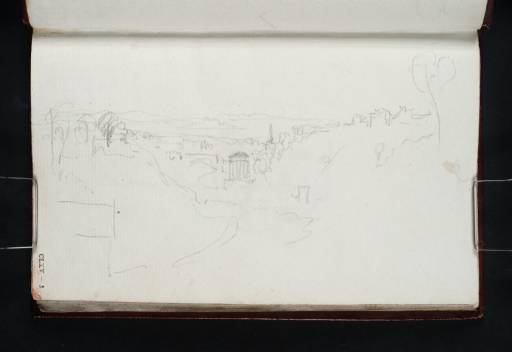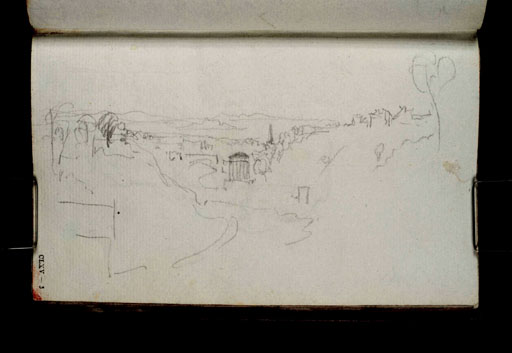Joseph Mallord William Turner Edinburgh from the Costorphine Hills with St Bernard's Well 1818
Image 1 of 2
Joseph Mallord William Turner,
Edinburgh from the Costorphine Hills with St Bernard's Well
1818
Joseph Mallord William Turner 1775–1851
Folio 3 Recto:
Edinburgh from the Costorphine Hills with St Bernard’s Well 1818
D13325
Turner Bequest CLXV 3
Turner Bequest CLXV 3
Pencil on white laid paper, 99 x 159 mm
Stamped in black ‘CLXV 3’ bottom left descending vertically
Stamped in black ‘CLXV 3’ bottom left descending vertically
Accepted by the nation as part of the Turner Bequest 1856
References
1909
A.J. Finberg, A Complete Inventory of the Drawings of the Turner Bequest, London 1909, vol.I, p.478, CLXV 3, as ‘Town on the Firth of Forth’.
Finberg’s tentative identification of this view as ‘Town on the Firth of Forth’ is correct, if vague. We stand on the Corstorphine Hills looking towards St Bernard’s Well in the centre of the picture with houses on the hill to the right and the Firth of Forth with the island of Inchkeith in the background and the shore of Fife beyond. It is surprising that Finberg missed the exact location as he identified the double-page sketches that Turner made of this view in 1801 (Tate D02885–D02886, D02836–D02837, D02840–D02841; Turner Bequest LV 51a–52, 19a–20, 21a–22).
On this trip Turner also made three further sketches of St Bernard’s Well (Edinburgh, 1818 sketchbook Tate D13572; Turner Bequest 63a; Scotch Antiquities sketchbook, Tate D13644 and D13645; Turner Bequest CLXVII 35 and 36), and took views of Edinburgh from the nearby village of Dean (Tate D13738–D13742; Turner Bequest CLXVII 31b–33). The neoclassical monument at St Bernard’s Well, designed by Alexander Nasmyth (a fellow contributor to the Provincial Antiquities) in 1789, adds a Claudian note to the scene which is enhanced by the framing trees at the left and right and the serpentine Water of Leith which Turner could have easily worked up into a full classical landscape in the studio had he chosen to. Edinburgh is sometimes described as the ‘Athens of the North’, so it is not surprising that Turner sought out and found a view that could so easily be rendered in such a style. Andrew Wilson writes about Turner’s ‘classicising’ in his Scottish work, and his attempt to ‘assimilate these subjects into the tradition of high art’.1
The Revd John Thomson painted a view of Edinburgh from Corstophine Hill for the second number of the Provincial Antiquities, published in August 1819, to which Scott wrote: ‘The view from these hills is one of the most magnificent in the neighbourhood of Edinburgh.’2 Whether or not Turner made this sketch with the idea of working it up for the Provincial Antiquities or just for his own interest and reference, it is not surprising that he returned to sketch this spot in 1818.
A small tear at the centre of the right edge of the page has been repaired.
Thomas Ardill
October 2007
Andrew Wilton, ‘Turner in Scotland: The Early Tours’, in Francina Irwin, Andrew Wilton, Gerald Finley, Tim Wigley and Nigel Huckstep, Turner in Scotland, Exhibition Catalogue, Aberdeen Art Gallery 1982, p.15. Wilton is writing about the work resulting from Turner’s 1797 and 1801 Scottish tours, but the observation applies here too.
How to cite
Thomas Ardill, ‘Edinburgh from the Costorphine Hills with St Bernard’s Well 1818 by Joseph Mallord William Turner’, catalogue entry, October 2007, in David Blayney Brown (ed.), J.M.W. Turner: Sketchbooks, Drawings and Watercolours, Tate Research Publication, December 2012, https://www


